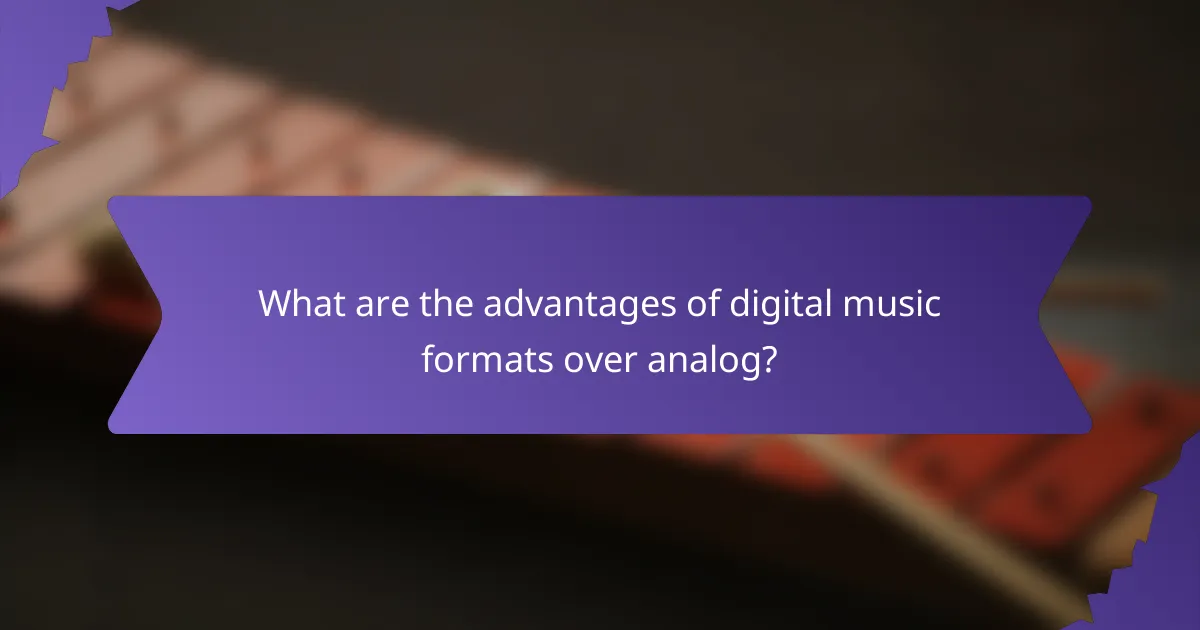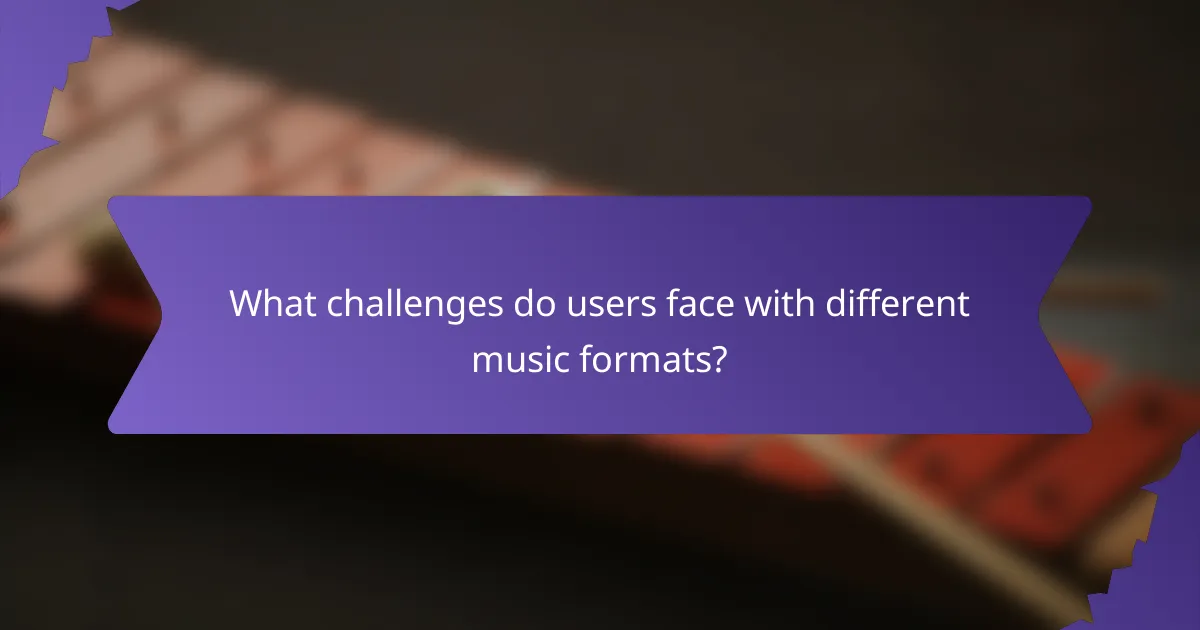The evolution of music formats from analog to digital has transformed how we experience sound. This article explores the advantages of digital formats, the rise of streaming services, and the resurgence of vinyl. It also examines emerging trends like high-resolution audio and the challenges users face with compatibility and sound quality. Understanding these dynamics can enhance your music consumption experience.

How did music formats evolve from analog to digital?
Music formats evolved from analog to digital through advancements in technology, enhancing sound quality and accessibility. Analog formats like vinyl records and cassette tapes relied on physical grooves and magnetic tape, while digital formats such as CDs and MP3s converted sound into binary code. This transition allowed for easier distribution, storage, and playback, significantly impacting how music is consumed. Future trends include high-resolution audio and streaming services, which continue to shape the music landscape.
What are the key characteristics of analog music formats?
Analog music formats are characterized by continuous waveforms, physical media, and warmth in sound quality. They include vinyl records, cassette tapes, and reel-to-reel tapes, each offering unique listening experiences. Vinyl records, for instance, provide rich sound depth, while cassette tapes offer portability. The tactile nature of analog formats enhances user engagement, creating a nostalgic connection. These attributes contribute to their enduring appeal despite the rise of digital formats.
What are the defining features of digital music formats?
Digital music formats are characterized by their ability to store audio data in a compressed or uncompressed manner, allowing for efficient playback and distribution. Key features include audio quality, file size, and compatibility with various devices. Common formats like MP3 and WAV differ significantly in compression methods and sound fidelity. The transition from analog to digital has enabled easier sharing and access, while future trends may focus on higher resolution audio and immersive sound experiences.
How has technology influenced the transition between formats?
Technology has significantly influenced the transition from analog to digital music formats. The shift began with the introduction of digital recording and playback technologies, allowing for greater precision and quality. Digital formats like MP3 and streaming services have transformed how music is consumed, emphasizing accessibility and convenience. As a result, artists and labels adapt to new distribution methods, impacting revenue models and listener engagement. Emerging technologies such as AI and blockchain are likely to shape future trends, potentially redefining ownership and interaction within the music industry.

Which music formats are currently most popular worldwide?
Digital music formats dominate globally, with streaming services leading the way. Popular formats include MP3, AAC, and FLAC, each serving different user preferences. Streaming platforms like Spotify and Apple Music have increased accessibility, shifting consumption from ownership to access. Vinyl records have seen a niche revival, highlighting a unique trend toward analog appreciation among audiophiles.
What role do streaming services play in music format preferences?
Streaming services significantly influence music format preferences by promoting digital consumption over analog. Their vast libraries and accessibility encourage listeners to favor formats like MP3 and streaming over vinyl or cassette. As a result, digital formats dominate the market, reflecting changing consumer habits and technological advancements. Streaming platforms also shape music discovery and sharing, further solidifying digital formats as the preferred choice among users.
How do physical formats like vinyl and CDs compare to digital formats?
Vinyl and CDs offer distinct listening experiences compared to digital formats. Vinyl provides warm sound quality and a tactile experience, while CDs offer durability and convenience. Digital formats excel in portability and accessibility.
| Format | Sound Quality | Durability | Portability | Experience |
|————-|——————-|—————-|——————|—————–|
| Vinyl | Warm, rich | Fragile | Low | Tactile, nostalgic |
| CDs | Clear, consistent | High | Moderate | Physical, collectible |
| Digital | Variable | High | Very high | Instant, versatile |

What are the advantages of digital music formats over analog?
Digital music formats offer several advantages over analog formats, including higher audio quality, greater storage efficiency, and enhanced convenience. Digital formats eliminate issues like distortion and degradation over time, ensuring consistent playback quality. They also support various compression techniques, allowing for more songs to be stored in smaller file sizes. Additionally, digital music can be easily shared and streamed, providing instant access to vast libraries. These attributes make digital formats more versatile and user-friendly compared to their analog counterparts.
How does sound quality differ between analog and digital formats?
Sound quality in analog formats often features warmth and depth, while digital formats provide clarity and precision. Analog recordings capture continuous sound waves, resulting in a richer tonal quality. In contrast, digital formats convert sound into discrete samples, which can lead to potential loss of nuances. However, advancements in digital technology, such as high-resolution audio, aim to bridge this gap. Ultimately, personal preference plays a significant role in the perceived quality of sound across these formats.
What are the benefits of accessibility and portability in digital formats?
Accessibility and portability in digital formats enhance user experience by allowing easy access and transport of music. Digital formats enable users to enjoy music on various devices, ensuring convenience and flexibility. They also facilitate seamless sharing and distribution, promoting wider reach for artists and content creators. Additionally, digital formats support diverse playback options, catering to different listening preferences and environments.

Which unique trends are shaping the future of music formats?
Emerging trends in music formats include increased use of high-resolution audio, immersive experiences, and subscription-based streaming services. These shifts reflect consumer demand for quality and accessibility. The rise of spatial audio technology enhances listener engagement, while vinyl records maintain a unique appeal due to their nostalgic value. Additionally, blockchain technology is shaping music distribution, ensuring artists receive fair compensation.
What innovations are emerging in music format technology?
Emerging innovations in music format technology include advanced compression algorithms, immersive audio formats, and blockchain for copyright management. These advancements enhance sound quality, accessibility, and artist compensation. For example, formats like Dolby Atmos provide spatial audio experiences, while lossless audio formats retain high fidelity. Additionally, streaming platforms are integrating AI to personalize music recommendations, improving user experience.
How are consumer behaviors changing regarding music consumption?
Consumer behaviors are rapidly shifting towards digital music consumption, driven by convenience and accessibility. The transition from analog formats like vinyl and cassette tapes to digital platforms has transformed how people access and enjoy music. Streaming services dominate the landscape, with over 80% of music consumption occurring through platforms like Spotify and Apple Music. This trend reflects a unique attribute of modern music consumption: the preference for on-demand access over ownership. Additionally, social media influences music discovery, making it easier for users to engage with new artists and genres. As a result, the future of music consumption will likely continue to evolve, emphasizing personalized experiences and innovative technologies.

What challenges do users face with different music formats?
Users face various challenges with music formats, including compatibility issues, sound quality differences, and accessibility concerns. Different formats like MP3, FLAC, and vinyl each present unique attributes affecting user experience. For instance, MP3 offers convenience but lacks the audio fidelity of FLAC. Vinyl provides a rich sound but requires special equipment. As a result, users must navigate these trade-offs when choosing formats, impacting their overall enjoyment and accessibility to music.
What are common issues with digital music formats?
Common issues with digital music formats include compression artifacts, compatibility problems, and loss of audio quality. Compression often reduces file size but can degrade sound fidelity. Some formats lack support across devices, leading to playback difficulties. Additionally, metadata inconsistencies can affect organization and searchability in music libraries.
How do copyright and licensing impact music format usage?
Copyright and licensing significantly influence music format usage by dictating how music can be distributed and consumed. Rights holders control access to both analog and digital formats, affecting availability and pricing. Digital formats have revolutionized distribution, yet licensing complexities can limit usage in various regions. Emerging trends indicate a move towards more flexible licensing models to adapt to evolving consumption patterns.

Which rare music formats are gaining attention in niche markets?
Vinyl records and cassette tapes are rare music formats gaining attention in niche markets. Vinyl has seen a resurgence due to its unique sound quality and tangible experience. Cassette tapes are attracting collectors for their retro appeal and nostalgia. Both formats offer distinct listening experiences that digital cannot replicate, appealing to audiophiles and vintage enthusiasts.
What unique attributes do formats like high-resolution audio offer?
High-resolution audio formats offer superior sound quality, capturing more detail than standard formats. This results in a richer listening experience, appealing to audiophiles. Unique attributes include higher bit rates and sample rates, allowing for greater dynamic range and clarity. Additionally, these formats often support lossless compression, preserving audio fidelity.
How are collectible formats influencing music culture?
Collectible formats are reshaping music culture by creating a deeper connection between artists and fans. Vinyl records, cassette tapes, and limited-edition releases foster nostalgia and community. These formats encourage collectors to engage with music on a personal level, enhancing the overall experience. As a result, the revival of analog formats influences contemporary music consumption trends, merging past and present.

What best practices should users follow when choosing music formats?
When choosing music formats, prioritize sound quality, compatibility, and storage efficiency. Select formats like FLAC for lossless quality or MP3 for smaller file sizes. Consider future-proofing by opting for widely supported formats. Evaluate your playback devices to ensure compatibility with your chosen format.
How can users optimize their music collection across different formats?
Users can optimize their music collection by converting physical formats to digital and organizing files effectively. Transitioning from vinyl or CDs to digital formats enhances accessibility and storage efficiency. Utilize lossless formats like FLAC for high-quality sound or MP3 for portability.
Regularly update and back up your collection using cloud services to prevent data loss. Tagging files with metadata ensures easy searching and sorting. Consider using dedicated music management software to streamline organization and playback. Embracing future trends like streaming and high-resolution audio can further enhance the listening experience.
What common mistakes should be avoided when transitioning formats?
Transitioning from analog to digital music formats involves several common mistakes to avoid. Ensure proper planning and understanding of digital formats to prevent quality loss.
1. Ignoring sound quality differences: Digital formats can compress audio, leading to potential loss of fidelity. Choose high-resolution formats when possible.
2. Overlooking metadata: Failing to include accurate metadata can hinder organization and searchability. Proper tagging is essential for digital libraries.
3. Skipping backup processes: Neglecting to back up digital files can result in data loss. Regular backups are crucial for preserving music collections.
4. Underestimating file organization: A disorganized digital library can make finding music difficult. Establish a clear folder structure and naming convention.
5. Not considering future compatibility: Some formats may become obsolete. Opt for widely supported formats to ensure longevity and accessibility.